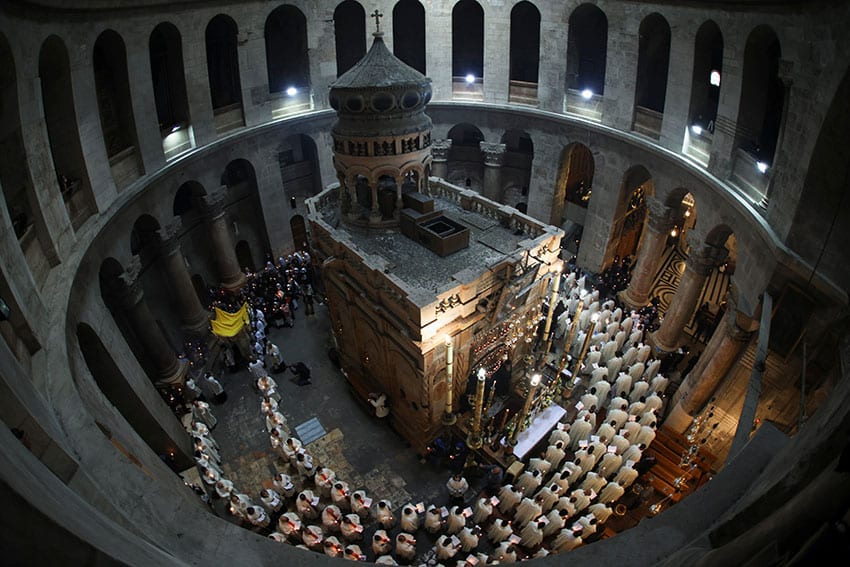
A friend says he has seen a ceremony in the Holy Sepulchre in Jerusalem on the Orthodox Holy Saturday in which a candle is supposedly lit miraculously? Is this credible?
What is certain is that every year on Holy Saturday in the Orthodox calendar, thousands of people gather in and outside the Church of the Holy Sepulchre in Jerusalem, to have their candles lit from the candles of the Greek Orthodox Patriarch, whose candles have supposedly been lit miraculously from fire emanating from the tomb of Christ.
Known as the ceremony of Holy Light or Holy Fire, it is one of the most sacred rituals in the Orthodox calendar and it dates back to at least the eighth century.
The ceremony is similar to the lighting of candles from the Easter candle in Catholic churches in the Easter vigil throughout the world, and it has the same significance, representing the joy of the resurrection of Christ.
What exactly happens in the Holy Sepulchre?
The ceremony begins at 10am in the Armenian Cathedral of St James, where members of the Muslim Joudeh family, holders of the key to the church of the Holy Sepulchre since at least the 12th century, temporarily entrust the key to the Armenian Patriarch.
The Patriarch and other church leaders then process to the Holy Sepulchre, an approximately ten-minute walk.
At 11am they hand the key to the Muslim doorkeeper, Nuseibeh, who opens the door, and those lucky enough to be allowed in, throng the church.
Pilgrims carry candles with which to receive the holy light and they sing traditional songs and chants, with dancing and the beating of drums.
At 1pm the civil authorities make their way through the crowd to the Aedicule, the shrine built over the tomb of Christ.
They enter the shrine to check that no source of fire has been left inside it. They then seal the door with wax, a reminder of the Roman soldiers sealing Jesus’ tomb to ensure that the disciples did not steal his body.
The people outside chant “Christ is Risen” in many languages.
At 1.45pm the Greek Orthodox Patriarch arrives, with a procession of clergy. They circle the Aedicule three times.
The Patriarch’s robes are then removed and checked to ensure he does not carry any hidden source of fire.
The wax seal on the Aedicule is broken and a single unlit oil lamp is taken inside and placed on the marble slab above the stone where Christ’s body was laid.
Then the Greek Patriarch enters the Aedicule carrying two bundles of unlit candles. Each bundle contains 33 candles, symbolising the 33 years of Jesus’ life.
The Patriarch kneels before the lamp and prays, reciting an ancient prayer passed down through the centuries.
Opinion varies as to exactly what happens next and whether it is miraculous or not. Some say that fire comes down from the heavens through a skylight in the Aedicule. Others say that it emanates from the marble slab over the tomb itself. Only the Patriarch witnesses exactly what happens.
Meanwhile, all the lights in the church are extinguished and the crowd waits in darkness.
When the Patriarch emerges from the Aedicule with his candles lit, shouts of joy erupt from the crowd. The holy fire is used first to light the candles held by the Patriarchs of the Armenian and Coptic Orthodox Churches and then it is passed from one candle to another in the crowd.
The flame quickly spreads around the church, amid shouts of joy, with dancing, the beating of drums and the ringing of bells.
There have been many eyewitness accounts over the years of pilgrims’ candles miraculously igniting as they wait in the darkened church before the Patriarch has emerged with the holy light.
It is also said that the holy fire has special properties, such that for the first 33 minutes it will burn without giving off heat, so that people can put their hands over the flames without being burnt.
As regards its history, around 385 AD the Spanish pilgrim Egeria wrote of a ceremony in the Holy Sepulchre in which a light came forth from the chapel around the tomb, filling the entire church with light.
And in 867, the pilgrim monk Bernard the Wise is believed to be the first person to have recorded the Holy Fire. So there is a long tradition regarding the ceremony.
